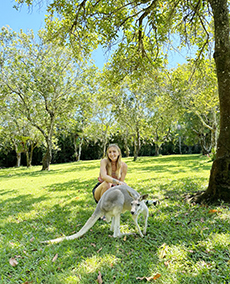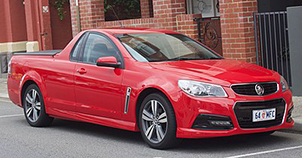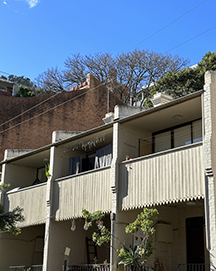By Cameryn Cass
The first time I left America, I didn’t get very far: I went to Toronto for a mini-holiday. Though only four and a half hours from my hometown, it felt much farther than that. It was exciting and new and – dare I say – foreign. Unlike my 19-year-old peers, I was drawn to the city for something other than legal drinking: I went in search of adventure.
You see, I enjoy living outside my comfort zone. I figure the more I do, the larger that zone will become.

Former Great Lakes Echo writer Cameryn Cass on the scene in Australia
So for my final semester at Michigan State, I decided to pack my bags and live 9,370 miles (15,080 kilometers) from home in Sydney, Australia. Instead of studying abroad, I interned at a lovely nonprofit called the Ethics Centre in the heart of the city.
I had the opportunity to write and edit stories and meet philosophers and experience imposter syndrome daily. I got used to spelling color with a “u” and writing the date with the number first, followed by the month. Did you know writing the date with the number sandwiched between the month and year is almost exclusively American? I think we ought to reconsider how we write that. And also adopt the metric system.
But, back to Australia. My internship went from February to mid-April, but I stayed until July 24 (24 July). I saw Brisbane and sat beside kangaroos all afternoon at Steve Irwin’s Australia Zoo. I hiked at Cradle Mountain and easily fell in love with Hobart, Tasmania.
I visited New Zealand and its Hobbiton, having never seen the Hobbit or Lord of the Rings films and left a piece of my heart in Queenstown.
And I got lost in the equatorial heat and traffic lightless roads of Bali, visiting my cousin there for 15 days.
I’ve had a helluva time these past six months. I met each day and person with curiosity and learned so much about different approaches to life from people on the other side of the planet.
As a (former) environmental journalism student and advocate for all things wild, I was especially curious about what these places were doing to both combat and adapt to climate change. And I found Australia to be significantly ahead of America in that arena.
I grew up in a small Michigan town surrounded by farmland, so I’m used to seeing massive, petrol-sucking pickup trucks crowd the roads.

An Australian ute. Photo credit Cameryn Cass
But when I got to Sydney, I immediately noticed a lack of these vehicles, though they’re apparently getting more popular. Of course, I saw some, but it was rare, even when I left the city. They still used trucks – utes – but they were smaller and looked much less threatening, like a backwards baseball cap with wheels. What’s more, they get, on average, 10 or more miles per gallon (4 kilometers per litre) than the petrol-sucking pickups Americans seem to love.
One of the more surprising things the country lacked, though, were ubiquitous clothes dryers. The accommodation I lived in was the only home I entered with one in it.
I remember my Aussie friends coming over and being surprised at the luxurious commodity, which I’d always taken for granted. As it turns out, under 60% of Australian households have drying machines, while 80% of American homes do. In lieu of dryers, Aussie households have outdoor clotheslines or pop-up racks to hang their clothes on. Air drying, unsurprisingly, is much less damaging to clothes than machine drying, as the latter tends to strip their colo(u)r from them over time and sometimes shrink them. Plus, the sun and fresh air can kill bacteria and dust mites that sometimes live in fabric.

Australians rely more heavily than Americans on clotheslines rather than electric dryers. Photo credit: Cameryn Cass
Machine drying comes with additional environmental — and monetary — costs. Laundry is responsible for nearly a third of America’s residential carbon emissions, and drying is the greatest contributor. If every American household exchanged dryers for lines, we stand to knock 6% off our total annual carbon emissions. Plus, depending on how frequently a household dries clothes and what machine it uses, it could save anywhere from $15 to nearly $50 annually in the eco-friendly swap.
Another thing I noticed was a lack of plastic bags in the grocery stores. As someone who always brings her own bag, I noticed how the other shoppers did too, or paid for plastic ones, like you would at Aldi.
American self-checkout lines have cheaply made plastic bags readily available, but in Australia, stores offer high quality bags, which encourage people to reuse them. Plus, the bags cost money and were located away from checkout lines, which discouraged people from using them — especially if they had a small purchase and didn’t especially need one.
The same goes for leftovers at restaurants: Most places charge a small fee (25 cents to a dollar) for takeaway containers. And then you get a sturdy plastic box for your leftovers that felt as reliable as Glad Tupperware, so I reused mine time and again. In fact, in all my time there, I didn’t buy any Tupperware: With takeout boxes like that, there wasn’t any need.
I also wasn’t given a single Styrofoam takeout box.
Australia’s plastic waste plan, which had a goal to phase out the polystyrene foam by 2022, clearly wasn’t a hollow one. The plan tackled plastic pollution at its source by stopping use of plastics that didn’t meet its new compostable standards- like Styrofoam.
Additionally, for plastics they do use, the Australian government has goals to make them either reusable or compostable by 2025.
Coming home, it’s been strange – and awfully sad – to see Styrofoam boxes and plastic cutlery once again. America has outlined plans and “actions” to address plastic pollution, but most of the suggested solutions are voluntary and the goals are vague and for the future. For instance, the Environmental Protection Agency “reaffirmed the goal to increase the U.S. recycling rate to 50% by 2030,” as part of the National Recycling Strategy.
In tandem with Australia’s successful plastic initiatives, Sydney recently made it simpler to recycle things that typically end up in the trash bin, like toys and electronics. It’s a paid service called RecycleSmart, and it’s essentially an Uber for trash. Interested Aussies can pay $5 AUD for one bag or $10 for two, and the company will pick it up from their door. Already, the company has diverted over 950,000 pounds (430,700 kilograms) of rubbish from the tip (Aussie slang for landfill).
From the six months I spent in Australia, I can confidently say that they’re much more eco-friendly, as a whole, than America. And maybe it’s because the general public is more interested in being green. Or maybe their population of 25 million is easier to manage and more willing to follow new initiatives than America’s 330 million.
Whatever it is, I felt that everyone there was working toward a shared goal of sustainability, while in America, it very much still feels like a solo pursuit. I can bring my own bags to the store and my own thermos for coffee, but realistically, how much of an impact am I, alone, making?
If our stores discouraged people from using plastic bags, our restaurants switched out Styrofoam for compostable containers and our government made meaningful initiatives with short implementation deadlines to encourage action, then we’d be on a more sustainable track. The way Aussies live is extremely similar to the way we live, with a few minor differences. It’s proof that making these changes is achievable if the right people are interested in making it a priority.
Cameryn Cass is an alum of Michigan State University’s environmental journalism program and a former writer for the Knight Center’s Great Lakes Echo.
